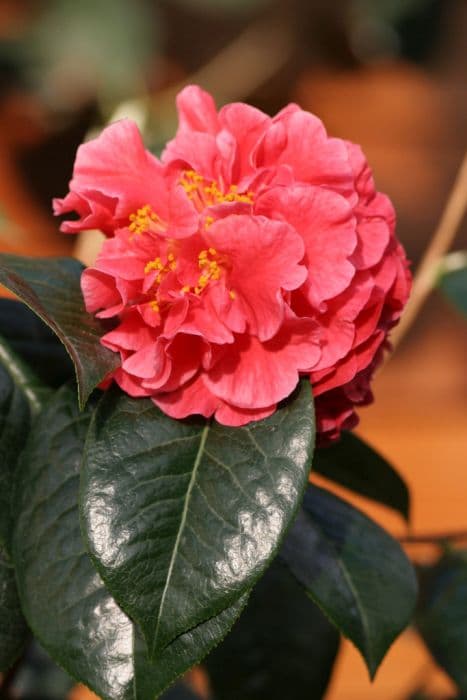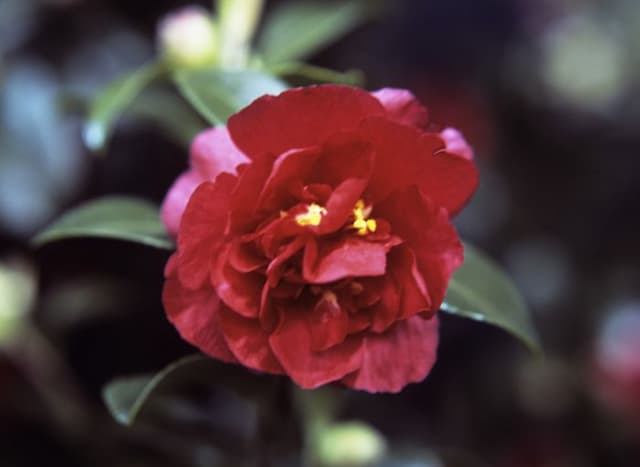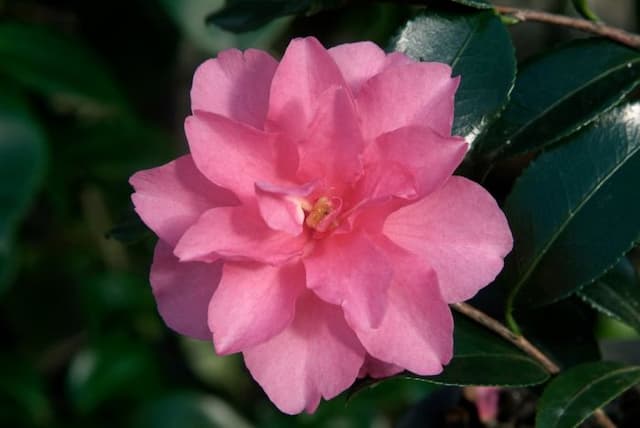Japanese Camellia Camellia japonica 'Betty Sheffield Pink'

ABOUT
The Camellia japonica 'Betty Sheffield Pink' is an elegant flowering plant known for its gorgeous, showy blooms. The flowers of 'Betty Sheffield Pink' are semi-double to peony-form, meaning they have several layers of petals that are not as densely packed as full double blooms, but more so than single blooms. The petals are a delicate shade of pink, often exhibiting variations in hue that can range from a soft, pale pink to a more pronounced pink with a hint of peach or coral. The edges of the petals can have a soft, ruffled appearance, adding a touch of grace to the plant's overall presentation. The center of the flower is studded with bright yellow stamens, which contrast vividly against the pink petals and attract pollinators to the plant. Surrounding the flowers are glossy, dark green leaves that are oval to elliptical in shape with a pointed tip and serrated edges. These leaves are leathery in texture and provide a year-round display of lush, evergreen foliage that serves as a perfect backdrop for the floral display. 'Betty Sheffield Pink' blooms typically emerge in the late winter to early spring season, providing color and interest at a time when many other plants are still dormant. The plant is an excellent choice for gardeners who wish to add a touch of elegance and vibrant color to their garden landscapes, and it works wonderfully in decorative containers as well. Its flowers can also be cut for arrangements, allowing the beauty of 'Betty Sheffield Pink' to be brought indoors.
About this plant
 Names
NamesFamily
Theaceae.
Synonyms
Japanese Camellia, Rose of Winter, Tsubaki.
Common names
Camellia japonica 'Betty Sheffield Pink'.
 Toxicity
ToxicityTo humans
Japanese camellia is generally considered non-toxic to humans. There is no significant evidence to suggest that ingesting parts of the Japanese camellia, including the 'Betty Sheffield Pink' variety, leads to poisoning or adverse health effects in humans. Therefore, accidental ingestion is not expected to cause more than mild stomach upset, if any symptoms at all.
To pets
Japanese camellia is also generally considered non-toxic to pets. It is not known to cause poisoning in animals such as cats and dogs, and ingesting parts of the plant, including the 'Betty Sheffield Pink' variety, is unlikely to lead to severe symptoms. Nevertheless, as with any non-food plant, consumption in large amounts could potentially cause mild gastrointestinal discomfort or an upset stomach in some pets.
 Characteristics
CharacteristicsLife cycle
Perennials
Foliage type
Evergreen
Color of leaves
Green
Flower color
Pink
Height
6-12 feet (1.8-3.7 meters)
Spread
6-10 feet (1.8-3 meters)
Plant type
Shrub
Hardiness zones
7-9
Native area
Japan
Benefits
 General Benefits
General Benefits- Aesthetic Appeal: Japanese camellia produces large, showy pink flowers that enhance the visual appeal of gardens and landscapes.
- Year-Round Interest: With evergreen foliage, it provides greenery throughout the year, even when not in bloom.
- Low Maintenance: Once established, it requires minimal care, making it suitable for gardeners of all skill levels.
- Diversity in Landscaping: Its varying forms, from shrubs to small trees, allow for versatile use in landscape design.
- Privacy and Screening: Dense growth habit makes it effective for creating hedges and privacy screens.
- Erosion Control: The plant's root system helps stabilize soil on slopes, reducing erosion.
- Habitat for Wildlife: Offers shelter and foraging opportunities for birds and beneficial insects.
- Seasonal Blooms: Flowers in late winter to early spring, providing color when many other plants are dormant.
- Durable: Tolerates a range of soil types and can withstand occasional cold snaps once mature.
 Medical Properties
Medical PropertiesThis plant is not used for medical purposes.
 Air-purifying Qualities
Air-purifying QualitiesThis plant is not specifically known for air purifying qualities.
 Other Uses
Other Uses- Camellia blooms as an art medium: The petals of the Camellia can be pressed and used in floral art creations due to their vibrant color and texture.
- Edible garnish: The Camellia japonica 'Betty Sheffield Pink' flowers can be used as an edible garnish in culinary presentations after ensuring they haven't been treated with pesticides.
- Pressed flower bookmarks: The flowers can be dried and pressed to create unique, decorative bookmarks.
- Eco-friendly confetti: Dried petals of the Camellia can serve as a biodegradable alternative to traditional paper confetti at celebrations.
- Fabric dye: The petals of the Camellia can be used to naturally dye fabrics a soft pink hue.
- Botanical photography subject: Due to its stunning appearance, this Camellia variety can be an excellent subject for botanical photography and plant-based art projects.
- Floral bath salts: The petals can be mixed with Epsom salts and essential oils to create fragrant floral bath salts.
- Culinary syrup infusion: The petals can be used to infuse syrups for use in desserts or cocktails, adding a subtle floral note.
- Horticultural competitions: Camellia enthusiasts may cultivate 'Betty Sheffield Pink' for participation in flower shows and horticultural contests.
- Traditional Japanese Tsubaki oil: While more commonly associated with Camellia oleifera, petals of Camellia japonica can also be used to contribute to the fragrance of Tsubaki oil, a traditional Japanese hair and skin care product.
Interesting Facts
 Feng Shui
Feng ShuiThe Camellia is associated with positive energies in Feng Shui, often symbolizing love, affection, and admiration. To harness these energies, place Camellias in the southwest area of your garden or home to enhance love and relationship luck, or in living areas to promote a flourishing and joyous family life.
 Zodiac Sign Compitability
Zodiac Sign CompitabilityThe Camellia is not used in astrology practice.
 Plant Symbolism
Plant Symbolism- Adoration and Devotion: Camellias often symbolize deep desire and heartfelt emotions. The 'Betty Sheffield Pink' variety, with its lush pink petals, can be particularly evocative of tender affection and admiration.
- Longevity and Faithfulness: As an evergreen with a long blooming period, the Camellia represents endurance and the long-lasting nature of love. This makes it a popular gift for couples to express their commitment to one another.
- Perfection and Excellence: With its perfect form and beauty, the Camellia is associated with the ideal. The 'Betty Sheffield Pink', with its large, impeccably formed flowers, embodies this symbolism beautifully.
 Water
WaterJapanese Camellia, commonly known as 'Betty Sheffield Pink', prefers consistently moist soil but is not tolerant of waterlogged conditions. It should be watered deeply once a week, providing around 1 to 1.5 gallons of water each time, depending on the weather conditions. During dry spells or hot weather, frequency may need to increase to prevent the soil from drying out completely. During the winter months, watering should be reduced to when the soil feels dry to the touch, as the plant requires less moisture during this period of dormancy.
 Light
LightJapanese Camellia 'Betty Sheffield Pink' flourishes in partial shade, where it is protected from the harsh afternoon sun. The ideal spot is one where it can receive filtered morning light but is shaded during the more intense heat of the day. Direct sunlight can cause scorching of the leaves, so a location under the dappled shade of tall trees or on the north or east side of a building is preferred.
 Temperature
TemperatureJapanese Camellia 'Betty Sheffield Pink' thrives in temperate climates with ideal temperatures ranging between 60 to 80 degrees Fahrenheit. It can tolerate minimum temperatures down to around 20 degrees Fahrenheit, and it should be protected from extreme cold as it may not survive temperatures below this threshold. However, it will tolerate brief exposure to colder temperatures if it is well-established and in a sheltered location.
 Pruning
PruningJapanese Camellia 'Betty Sheffield Pink' benefits from pruning to maintain its shape, remove dead or weak branches, and encourage flowering. Pruning should occur after the blooming season, typically in late winter or early spring. Thinning the plant every few years helps to improve air circulation and light penetration, which is crucial for the overall health and vitality of the camellia. Pruning is also the time to remove any branches that grow inward toward the center of the plant to maintain an attractive, open form.
 Cleaning
CleaningAs needed
 Soil
SoilCamellias prefer acidic soil with pH between 5.5 and 6.5. The best soil mix for Japanese Camellia 'Betty Sheffield Pink' is one that provides good drainage and is rich in organic matter. A blend of 50% peat moss, 30% garden soil, and 20% perlite or pine bark mini nuggets will create an ideal environment for their roots. Mulching with pine bark or pine needles can help maintain the acidity and moisture levels in the soil.
 Repotting
RepottingJapanese Camellia 'Betty Sheffield Pink' typically requires repotting every 2-3 years, or when it becomes root-bound. It is best to repot in the spring, just after blooming has finished. This schedule allows the plant to establish in the new container before the onset of winter.
 Humidity & Misting
Humidity & MistingJapanese Camellia 'Betty Sheffield Pink' thrives at moderate to high humidity levels, ideally between 40% and 60%. If indoor air is too dry, particularly in winter months, consider using a humidifier or a pebble tray to raise the moisture content in the surrounding atmosphere.
 Suitable locations
Suitable locationsIndoor
Place Japanese Camellia near a window with bright, indirect light.
Outdoor
Plant in partial shade, sheltering from afternoon sun and wind.
Hardiness zone
7-9 USDA
 Life cycle
Life cycleCamellia japonica 'Betty Sheffield Pink', commonly known as Betty Sheffield Camellia, begins its life cycle as a seed, germinating in moist, well-drained soil, ideally during spring or autumn. Once the seedling establishes itself, it enters a vegetative stage, growing into a shrub with glossy, evergreen leaves and developing a robust root system. The Betty Sheffield Camellia progresses into the flowering stage, typically from late winter to spring, producing large, showy pink flowers with a mix of petaloid stamens. After pollination, which is often assisted by insects, the plant produces dry capsules containing the seeds which, when mature, open to release seeds for propagation. The shrub continues to mature over several years, often reaching full size in 10-15 years, during which it will enter a period of maintenance where it continues to flower annually while requiring pruning for shape and health. At the end of its lifecycle, which can be several decades long, the plant will gradually decline in vigour, eventually ceasing to produce new growth and flowers before dying.
 Propogation
PropogationPropogation time
Spring to early summer
Camellia japonica 'Betty Sheffield Pink', commonly known as the Japanese camellia, is most effectively propagated during the late winter or early spring months just before new growth begins. The favored method for propagating this lovely flowering shrub is through semi-hardwood cuttings. Semi-hardwood cuttings are taken from the current year's growth where the wood has started to harden but is not yet fully mature. Cuttings should be about 4 to 6 inches long and contain at least two sets of leaves. The bottom set of leaves is removed, and the cut end is often dipped in a rooting hormone to promote root development. Then, the cutting is placed in a well-draining potting mix and kept humid and warm until roots develop, which can take several weeks. During this time, it's vital to maintain a high humidity level around the cuttings to prevent them from drying out, often by covering them with a plastic bag or placing them in a propagation chamber.









